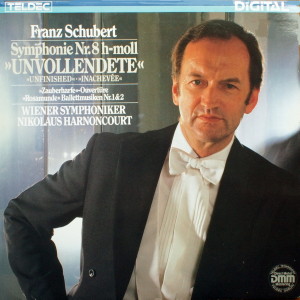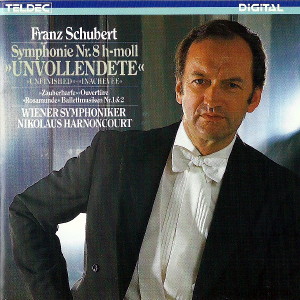 |
1 LP -
6.43187 AZ - (p) 1985
|
 |
| 1 CD -
8.43187 ZK - (p) 1985 |
|
| Franz Schubert
(1797-1828) |
|
|
|
|
|
|
|
| Symphonie Nr. 8 h-moll, D 759
"Die Unvollendete" |
|
27' 44" |
|
| - Allegro
moderato |
15' 56" |
|
A1 |
| - Andante
con moto |
11' 48" |
|
A2 |
| Ouvertüre zum Zauberspiel
"Die Zauberharfe", D 644 |
|
|
|
- Andante - Allegro vivace
|
|
10' 59" |
B1 |
|
|
|
|
| Rosamunde, Fürstin von
Zypern, D 797 |
|
16' 08" |
|
| - Ballettmusik Nr. 1 - (Allegro
molto moderato - Andante un poco assai) |
8' 30" |
|
B2 |
| - Ballettmusik Nr. 2 -
(Andantino) |
7' 38" |
|
B3 |
|
|
|
|
| Wiener
Symphoniker |
|
| Nikolaus
Harnoncourt, Leitung |
|
|
Luogo
e data di registrazione
|
Musikverein,
Vienna (Austria) - dicembre 1984
|
|
Registrazione
live / studio
|
| studio |
Producer
/ Engineer
|
-
|
Prima Edizione CD
|
| Teldec
- 8.43187 ZK - (1 cd) - 55' 26" - (p)
1985 - DDD |
Prima
Edizione LP
|
Teldec - 6.43187
AZ - (1 lp) - 55'
26"
- (p) 1985 - Digital
|
|
| The
"Unfinisched" Symphony |
Remarkably,
the fact is almost unknown that Haydn,
Mozart and Beethoven, the chief
exponents of the so-called Viennese
Classical School, used literary models
as a source of inspiration. Not that
they had any intention of conveying the
subject matter of the “models” to the
listener in the way that programme music
does; on the contrary, the link with
particular models was rarely mentioned.
Important though the narrative may have
been as a source of inspiration, the
listener was not supposed to find out
about it. Even though contemporary music
lovers must surely have been aware of
such cross connections between music and
literature, the actual provenance of a
specific work was clearly of no
importance. Today’s musician and music
lover, having to leam from scratch to
appreciate the musical language of the
past, may derive much interest and
valuable assistance from an awareness of
these interrelations.
By the end of the 18th century this link
between music and literature was already
a long-established tradition and seems
to have been taken for granted. There
are several references to the use of
literary sources, and occasionally a
composer would be asked to make up a
story to fit his composition. For all
that this methods was unhesitatingly
used, it was considered something of a
trade secret, something known among
composers which, though sometimes
mentioned in theoretical works, was
never to be acknowledged in public.
Tartini, for example, noted the models
for his violin concertos on the scores
in a kind of code. Haydh told his
biographer Carpani that he made a point
of making up a story before writing a
symphony (or sonata); as an example he
quoted the well-known “America
Symphony”. Beethoven at one time
intended to indicate the literary models
of his piano sonatas by giving titles to
the various movements, but in the end he
abandoned the idea. In the thirties
Arnold Schering researched these
connections in depth. He also discovered
the link between Schubert’s allegorical
tale “My Dream” and his “Unfinished
Symphony”. I basically follow his
description.
In this narrative the 26-year old
composer unburdended himself of a
youthful experience which evidently made
a deep and lasting impression upon him.
When he was about 15 years old his
father repeatedly forbade him to
compose; when this was to no avail, he
drove him away (Schubert was a boarder
at the Imperial Choir School), so that
he was deprived of a last opportunity of
seeing his beloved mother, who fell ill
and died during his banishment. It was
only at the graveside that he was
reconciled with his father and
readmitted to the parental home. Ten
years later he recorded this event in
the form of an allegorical dream:
My Dream (3rd July 1822)
I was a brother of many brothers and
sisters. Our father and our mother were
good people. I was deeply devoted to
them all. - Once my father led us to a
feast. This made my brothers very merry.
But I was sad. Then my father approached
me and commanded me to enjoy the
delicious food. But I could not do so,
whereupon my father, becoming angry,
banished me from his sight. I tumed my
footsteps and, my heart full of infinite
love for those who scorned it, I
wandered into distant lands. For many
years I felt immense grief and immense
love tear me apart. Then I received news
of my mother’s death. I hastened to see
her, and my father, mellowed by sorrow,
did not prevent me entering. I beheld
her corpse. Tears flowed from my eyes. I
saw her lying there like the dear old
past according to which, in the
deceased’s opinion, we ought to conduct
ourselves.
And we followed her corpse in sorrow,
and the coffin sank to earth. - From
then on I stayed at home again. Then my
father led me once more to his favourite
garden. He asked me whether I liked it.
But the garden was quite repellent to
me, yet I dared not say so. Then,
becoming incensed, he asked me for the
second time: Did I like it? I denied,
trembling. At that my father struck rne
and I fled. And I turned away for the
second time and, my heart full of
infinite love for those who scorned it,
I wandered again into distant lands. I
sang my songs for many a long year. If I
attempted to sing of love, it turned to
grief. Yet if I wanted to sing of grief
alone, it turned to love.
Thus love and grief tore me apart.
One day I had news of a gentle maiden
who had recently died. A circle formed
round her gravestone in which many
youths and old men walked as though in
everlasting bliss. They spoke softly,
lest they wake the maiden.
The maiden’s gravestone seemed to send
forth heavenly thoughts like fine sparks
upon the youth, producing a gentle
sound. I longed sorely to join them. But
they told me that only a miracle
admitted to this circle. But I went to
the gravestone with slow steps and
lowered gaze, full of devotion and firm
belief, and sooner than I knew I was
within the circle, from which issued
awondrous sound; and I felt eternal
bliss gathered up into a single moment.
I also saw my father, reconciled and
loving. He took me in his arms and wept.
But I wept even more.
Franz Schubert
Shortly afterwards, on 30th October
1822, Schubert embarked on the fair copy
of the symphony. Assuming than an
appropriate time had been spent on the
work, sketching and drafting, the
narrative and the symphony are
chronologically close to one another.
The narrative consists of two parts: (1)
The two incidents with his father and
the death of his mother. (2) Comfort and
transnguration in the realms of the
supernatural. The two movements of the
symphony correspond to the parts of the
narrative.
The first part is,as it were, structured
in literary sonata form. The first
conflict with his father and his
banishment correspond to the exposition
of the allegro moderato; his mother’s
death and the scene at the graveside
correspond to the development section;
the second conflict with his father
(which is not mentioned in Schubert’s
biography) corresponds to the
recapitulation. Even the structure is
full of parallels:
1st part
(Once my father led us to a feast)
...But I could not do so, whereupon my
father, becoming angry, banished me from
his sight.
I turned my footsteps and, my heart full
of infinite love for those who scorned
it, I wandered into distant lands.
For many years I felt immense grief and
immense love tear me apart.
2nd part
(Then my father led me once more to his
favourite garden) ..."Then, becoming
incensed, ...I denied, trembling. At
that my father struck and I fled.
And I turned away for the second time
and, my heart full of infinite love for
those who scorned it, I wandered again
into distant lands.
Thus love and grief tore me apart.
The
introduction and the two “triggers” - first the
delicious food and then the
favourite
garden, which serve as symbols that
justify his father’s severity - do not
occur in the symphony.
This symphony is not unhnished. Like the
dream narrative, it comes to a close
with a “celestial vision”. - It is true
that Schubert tried to carry matters
further in the music with a passionately
excited scherzo. He abandoned the
attempt, no doubt because he realised
that it was pointless; the work was
complete, finished in both senses of the
word. Schubert must have come to this
conclusion, otherwise he would, in the
years that followed, have completed the
symphony, this unique work of genius. He
himself described the two movements,
without further comment, as a
“symphony”; it was not unfinished, but
deliberately left in two-movement form.
(...)
Nikolaus
Harnoncourt
Translation:
Lindsay Craig
|
|
Nikolaus
Harnoncourt (1929-2016)
|

|

|
|